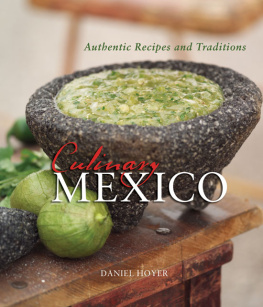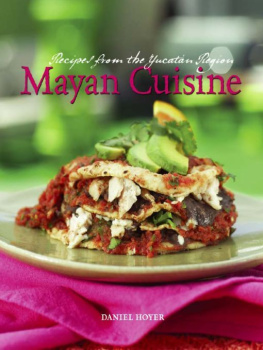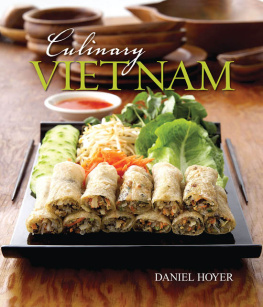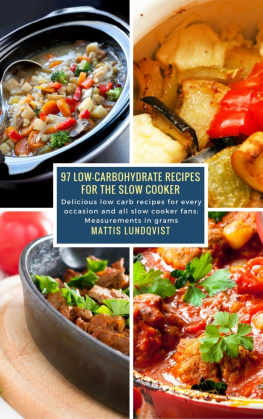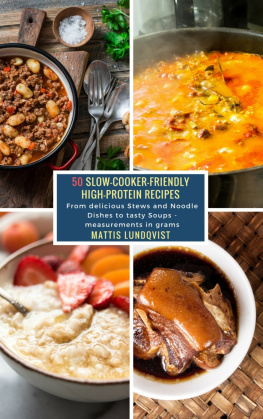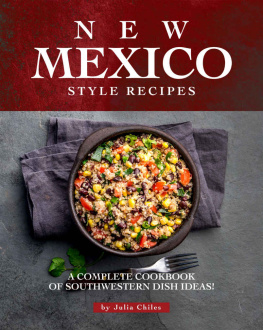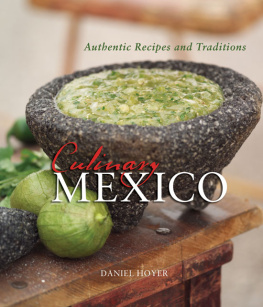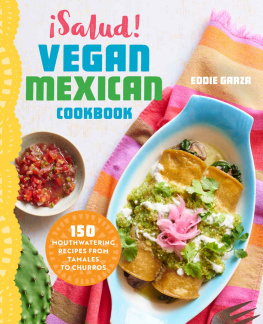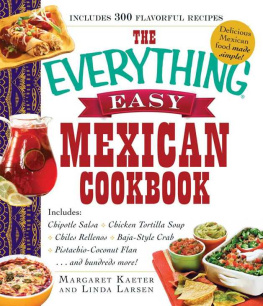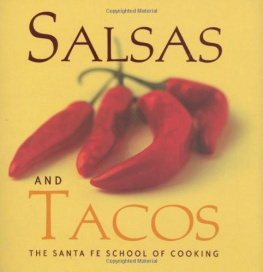Daniel Hoyer - Culinary Mexico: Authentic Recipes and Traditions
Here you can read online Daniel Hoyer - Culinary Mexico: Authentic Recipes and Traditions full text of the book (entire story) in english for free. Download pdf and epub, get meaning, cover and reviews about this ebook. City: Newburyport, year: 2005, publisher: Gibbs Smith, genre: Home and family. Description of the work, (preface) as well as reviews are available. Best literature library LitArk.com created for fans of good reading and offers a wide selection of genres:
Romance novel
Science fiction
Adventure
Detective
Science
History
Home and family
Prose
Art
Politics
Computer
Non-fiction
Religion
Business
Children
Humor
Choose a favorite category and find really read worthwhile books. Enjoy immersion in the world of imagination, feel the emotions of the characters or learn something new for yourself, make an fascinating discovery.
- Book:Culinary Mexico: Authentic Recipes and Traditions
- Author:
- Publisher:Gibbs Smith
- Genre:
- Year:2005
- City:Newburyport
- Rating:4 / 5
- Favourites:Add to favourites
- Your mark:
Culinary Mexico: Authentic Recipes and Traditions: summary, description and annotation
We offer to read an annotation, description, summary or preface (depends on what the author of the book "Culinary Mexico: Authentic Recipes and Traditions" wrote himself). If you haven't found the necessary information about the book — write in the comments, we will try to find it.
Frijoles Charros Cowboy-Style BeansLa Costa Oro; Al Pastor Pork Cooked with Pineapples and Chiles; Ceviche Citrus-Marinated Fresh Fish; Sopa del Pan Bread Soup; Tepache Fermented Pineapple Beverage; Pollo a las Brasas (Asados) Charcoal-Grilled Chicken on a Stick; Tamales de Camaron Nayarit Nayarit-Style Shrimp Tamales; Guacamole; Vinagre de Pina Pineapple Vinegar; Sopa de Flor de Calabaza Squash Blossom and Sweet Corn Soup; Camarones en el Mojo de Ajo Garlic Shrimp with Chiles; El Istmo; Bocadillos Potato Fritters; Robalo Relleno de Camaron y Jaiba Whitefish Stuffed with Shrimp and Crab.
Manchamanteles Fruity Red MoleHuachinango Veracruzano Veracruz-Style Red Snapper; Tamales de Anis sweet anise-seed tamales; Tapiste Veracruz-Style Chicken Steamed in Banana Leaves with Green Herb Sauce; Coctel de Camaron con Chipotle y Aguacate Shrimp Cocktail with Avocado and Chipotle Chiles; Pollo en Escabeche Oriental Eastern-Style Soused Chicken; Manilla Veracruz-Style Minced Fish; Chilpachole de Jaiba Crab and Epazote Stew with Chipotle and Tomato; Pescado Ajillo Fish Fillet with Chiles and Garlic; Helado de Coco Coconut Ice Cream; Salsa de Cacahuate Peanut and Chipotle-Chile Salsa.
Arroz Verde Green RicePierna de Cerdo Adobada Chile-Spiced Roast Pork Leg; Pay de Queso con Pina Cheese Pie with Pineapples; Cecina Enchilada Chile-Marinated Pork in Thin Sheets; Pasta de Chile Seco Xiqueno Veracruz-Style Chipotle-Chile Seasoning Paste; Camarones Enchipotlados Shrimp in Hot and Smoky Chipotle Sauce; La Encrucijada; Chiles en Nogada (Puebla) Chile Rellenos in Walnut Sauce with Pork-Picadillo Filling; Mixiotes Seasoned Meats Steamed in Maguey Wrappers; Tortillas de Maiz Corn Tortillas; Pepeto Mexico Pork Stew from the State of Mexico; Salpicon de Res Shredded Beef Salad.
Frijoles de Olla Slow-Cooked Black BeansMole Poblano de Convento Convent-style Puebla Mole; Arroz a la Poblana (blanco) Puebla-Style White Rice; Xolostle Chicken in a Red Chile Sauce; Crema de Cacahuate y Chipotle Peanut and Chipotle Cream Soup; Caldo de Pollo Chicken Broth; Caldo de Res Beef Broth; Salsa Fresca; Salsa Verde Green Taqueria-Style Sauce; El Centro Colonial; Uchepos Michoacan-Style Sweet Corn Tamales; Tamales de Muerto Queretaro Blue Corn Tamales with Pork; Churipo Country-Style Pork, Beef, and Chicken Stew; Sopa de Tomate con Fideos Tomato Soup with Vermicelli.
Quesadillas de Maiz con Garbanzos Frescos o Flor de Calabaza Corn Turnovers with Fresh Garbanzo or Squash-Blossom Filling. Read more...
Abstract: Introduction; Techniques and Ingredients; La Frontera; Queso Fundido Warm Cheese Dip; Machaca Nortena Northern-Style Shredded Beef; Cabrito Asado Nuevo Leon Nuevo Leon-Style Roasted Young Goat; Durango-Style White Beans; Empanadas de Harina Flour Pastry Turnovers; Caldo de Tomate con Albondigas de Pescado Tomato Broth with Fish Meatballs; Jocoque Mexican-Style Sour Cream; Tacos de Pescado Baja-Style Fish Tacos; Caldo de Habas con Nopales Fava Bean Soup with Cactus; Churros; Chiles Jalapenos en Escabeche Pickled Jalapeno Chiles; Caldillo Norteno Durango-Style Beef Stew.
Frijoles Charros Cowboy-Style BeansLa Costa Oro; Al Pastor Pork Cooked with Pineapples and Chiles; Ceviche Citrus-Marinated Fresh Fish; Sopa del Pan Bread Soup; Tepache Fermented Pineapple Beverage; Pollo a las Brasas (Asados) Charcoal-Grilled Chicken on a Stick; Tamales de Camaron Nayarit Nayarit-Style Shrimp Tamales; Guacamole; Vinagre de Pina Pineapple Vinegar; Sopa de Flor de Calabaza Squash Blossom and Sweet Corn Soup; Camarones en el Mojo de Ajo Garlic Shrimp with Chiles; El Istmo; Bocadillos Potato Fritters; Robalo Relleno de Camaron y Jaiba Whitefish Stuffed with Shrimp and Crab.
Manchamanteles Fruity Red MoleHuachinango Veracruzano Veracruz-Style Red Snapper; Tamales de Anis sweet anise-seed tamales; Tapiste Veracruz-Style Chicken Steamed in Banana Leaves with Green Herb Sauce; Coctel de Camaron con Chipotle y Aguacate Shrimp Cocktail with Avocado and Chipotle Chiles; Pollo en Escabeche Oriental Eastern-Style Soused Chicken; Manilla Veracruz-Style Minced Fish; Chilpachole de Jaiba Crab and Epazote Stew with Chipotle and Tomato; Pescado Ajillo Fish Fillet with Chiles and Garlic; Helado de Coco Coconut Ice Cream; Salsa de Cacahuate Peanut and Chipotle-Chile Salsa.
Arroz Verde Green RicePierna de Cerdo Adobada Chile-Spiced Roast Pork Leg; Pay de Queso con Pina Cheese Pie with Pineapples; Cecina Enchilada Chile-Marinated Pork in Thin Sheets; Pasta de Chile Seco Xiqueno Veracruz-Style Chipotle-Chile Seasoning Paste; Camarones Enchipotlados Shrimp in Hot and Smoky Chipotle Sauce; La Encrucijada; Chiles en Nogada (Puebla) Chile Rellenos in Walnut Sauce with Pork-Picadillo Filling; Mixiotes Seasoned Meats Steamed in Maguey Wrappers; Tortillas de Maiz Corn Tortillas; Pepeto Mexico Pork Stew from the State of Mexico; Salpicon de Res Shredded Beef Salad.
Frijoles de Olla Slow-Cooked Black BeansMole Poblano de Convento Convent-style Puebla Mole; Arroz a la Poblana (blanco) Puebla-Style White Rice; Xolostle Chicken in a Red Chile Sauce; Crema de Cacahuate y Chipotle Peanut and Chipotle Cream Soup; Caldo de Pollo Chicken Broth; Caldo de Res Beef Broth; Salsa Fresca; Salsa Verde Green Taqueria-Style Sauce; El Centro Colonial; Uchepos Michoacan-Style Sweet Corn Tamales; Tamales de Muerto Queretaro Blue Corn Tamales with Pork; Churipo Country-Style Pork, Beef, and Chicken Stew; Sopa de Tomate con Fideos Tomato Soup with Vermicelli.
Quesadillas de Maiz con Garbanzos Frescos o Flor de Calabaza Corn Turnovers with Fresh Garbanzo or Squash-Blossom Filling
Daniel Hoyer: author's other books
Who wrote Culinary Mexico: Authentic Recipes and Traditions? Find out the surname, the name of the author of the book and a list of all author's works by series.

